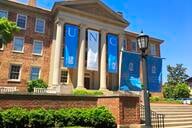You have /5 articles left.
Sign up for a free account or log in.
In a sign that college regulators may be struggling to cope with mergers and acquisitions, a regional accrediting agency has gone back and forth on whether two California colleges are able to ably govern themselves despite having board members with potential conflicts of interest.
The colleges -- Saybrook University, in Oakland, and Pacific Oaks College, near Los Angeles -- are both part of a relatively new Chicago-based nonprofit system known as T.C.S. Education System. T.C.S. oversees a handful of colleges, including the Chicago School of Professional Psychology.
The senior college commission of the Western Association of Colleges and Schools, which accredits institutions in California and Hawaii on behalf of the federal government, has detailed rules about how colleges ought to function. One requires college governing boards to be independent.
Because of this rule, WASC regulators have kept a close eye on Pacific Oaks and Saybrook since the two institutions became part of T.C.S. in 2010 and 2014, respectively. The system helps operate each college, but each college is its own nonprofit entity and has its own governing board.
The T.C.S. system was founded and is led by Michael Horowitz, who has quietly become one of the highest-paid higher education officials in the country. According to a 2013 tax filing, Horowitz earned $1.1 million that year, including about $550,000 in base pay and $370,000 in bonuses, along with other benefits.
The question is whether the handful of colleges T.C.S. has affiliated with are truly independent in the sense that they control their own fates. In recent emails and conversations, two different officials at the Western accreditor gave differing answers about whether the Pacific Oaks board met its standards on whether a college board is sufficiently independent to act in the best interests of the college.
At the very least, those different answers suggest regulators could have trouble coping with new higher education structures in coming years. Observers predict that private colleges will increasingly affiliate or merge to birth new types of organizational charts that pose new regulatory questions.
At public colleges, concerns about board independence often center on political interference from above. In Mississippi, for instance, an accreditor recently expressed concern that the state’s governor was meddling with the community college system. At private colleges, concerns about the board independence might center on money and who is on the board.
The tension at T.C.S. is simple: the system is affiliated with colleges it oversees and ostensibly operates, yet regulations are designed to make sure each college is sufficiently able to call its own shots.
The T.C.S. system itself is not a college, is not accredited and does not teach any students. Instead, the system -- a tax-exempt nonprofit -- provides administration and support services to the handful of nonprofit colleges it affiliates with. Each of those colleges is accredited and focuses on professional education programs. Those colleges include Saybrook, Pacific Oaks, the Chicago School and the Santa Barbara & Ventura Colleges of Law. All of those colleges, including the Chicago School, are now legally based in California. The system also oversees a two-year college in Texas, the Dallas Nursing Institute.
T.C.S. helped rescue Pacific Oaks in 2010 when the 1,100-student college was in danger of going under. The system give Pacific Oaks staff and services to help manage enrollment, legal, financial, marketing and technology issues. The two nonprofits shared about $18 million back and forth, according to tax records. About $9 million of that was money Pacific Oaks paid to T.C.S. to share staff with the system.
Pacific Oaks and T.C.S. also shared something else: board members and managers -- a majority of Pacific Oaks board members also serve on the T.C.S. board or are members of the system’s executive team. Six of the 11 Pacific Oaks board members are affiliated with T.C.S. -- five are T.C.S. board members and the sixth is Horowitz, the system president. A seventh board member is Pacific Oaks President Ezat Parnia. These relationships raise questions about whether Pacific Oaks’s board is able to make decisions for itself. For instance, what if the affiliation with T.C.S. stops making financial sense for the future of Pacific Oaks?
Because board members are obligated to make fiduciary decisions for the boards they sit on, if they sit on the boards of two entities that do business with each other, whom do they look out for during business transactions?
T.C.S. has defended its operations and said WASC has given its institutions the all clear about the boards of Saybrook and Pacific Oaks.
“Regarding board governance and the potential for conflict of interest, I can tell you that each board member’s fiduciary duty is to assure and sustain the institution in concert with its specific mission,” a system spokeswoman, Sherry Thomas, said in an email. “Accomplishing that mission is the measure of success irrespective of the history or lineage of any board member.”
This is where WASC’s rules get complicated.
In an emailed statement from WASC, an unnamed vice president expressed concern to Inside Higher Ed about whether Pacific Oaks was complying with WASC rules.
“The current [Pacific Oaks] board has 11 members and 6 are T.C.S.-E.S. board members or employees, so the board is not in compliance,” the statement, relayed through a spokeswoman, said.
But in a follow-up telephone interview, WASC President Mary Ellen Petrisko said Pacific Oaks may in fact be in compliance with its rules. That’s because of how WASC defines independence.
In spirit, WASC’s rules say that a majority of a board’s members “may not have interests that might impair their independent decision making, create multiple and potentially conflicting relationships, or result in competing loyalties.”
Specifically, WASC is clear about what counts as competing loyalty: a majority of a college’s board members must not be “employed by or owners of the institution.”
So, the T.C.S. board members who sit on the Pacific Oaks's board don’t count as nonindependent. Why? They are not considered owners by WASC: they are just T.C.S. board members who happen to also be Pacific Oaks board members.
Perhaps Horowitz, the system president, might count as a conflicted member, but he is only one man. Parnia, the Pacific Oaks president who sits on the board and is also a member of the T.C.S. executive council, does count as a conflicted board member because he is an employee -- but, again, he is only one man.
So, despite overlapping allegiances that mean a majority of Pacific Oaks board members have possible conflicts, these possible conflicts don’t add up to an actual conflict in WASC’s eyes.
Saybrook’s nine-member board also has a majority of members -- five -- with potential conflicts: three are also T.C.S. system board members, a fourth is Horowitz, and a fifth is Patricia Breen, the provost at Pacific Oaks.
On March 7, 2014, Petrisko, the head of WASC, wrote Saybrook’s then-president Mark Schulman a letter saying, “For a board to be considered independent, a majority of its members must have no affiliation with the institution or T.C.S.-E.S." (Since then, Schulman left Saybrook and became an executive in the T.C.S. system office.)
A year later, on March 6, 2015, Petrisko wrote Saybrook President Nathan Long another letter. This time, she gave Saybrook the all clear, even though five of nine board members have affiliations with T.C.S. or Pacific Oaks, which has its own affiliation with T.C.S. That was based on a report she received from a regulatory team looking at the university. “The team,” Petrisko wrote, “was ‘thoroughly impressed’ with the new board structure and the constitution of members.”
The system structure at T.C.S. may become something of a model. Horowitz has been asked to speak about the T.C.S. structure at a WASC symposium and, through a spokesman, praised the accreditor’s regulators.
“The guidance we have received from WASC has been of great benefit to [the system] and our affiliate institutions in creating an innovative governance structure that meets and exceeds WASC standards,” Horowitz said.
Petrisko said in an interview that accreditors have been accused of stifling innovation. This, she said, is not true, but the agency is staying true to its traditional mission, too, as the federal government’s watchdog to make sure government aid isn’t misspent.
“We are keenly aware of our responsibilities to make sure that as institutions are innovating they are doing so in a way that not only meets our standards but ensures that they are operating in the best interest of their students and other constituencies,” she said.
After affiliating with T.C.S., Pacific Oaks seemed to be doing better, according to regulators. They said enrollment, retention and finances are looking up.
Saybrook, a 600-student professional school that specializes in humanistic psychology for adults, though, seems to be struggling.
President Long recently announced Saybrook would lay off his and the provost’s executive assistants, the vice president of finance, the university communications director and the human resources manager -- as well as an unspecified number of faculty members. He also plans to end three degree programs and consolidate schools within the university.
Saybrook, Long said in a letter to the campus, has "been running deficits over the past several years, requiring us to dip into our already limited reserves, thus impacting our long-term sustainability.”




